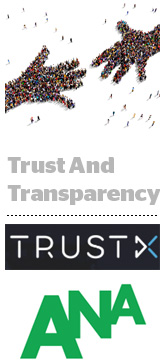
The Association of National Advertisers (ANA) said Wednesday it will partner with publisher trade body Digital Content Next (DCN) to encourage marketers to join DCN’s TrustX cooperative exchange, which promises access to viewable, brand-safe and premium inventory from DCN-member publishers.
“The marketplace TrustX and DCN built aligns with the digital supply chain priorities that the ANA has been championing,” said ANA EVP Bill Tucker.
Through the partnership, the ANA is advocating for its members to join a six-month pilot program on the TrustX exchange, which is still in beta. Marketers can join the pilot by reallocating a small portion of their existing media budgets onto TrustX.
So far, five agency holding companies have joined the marketplace and TrustX is already gaining interest from marketers, said TrustX President and CEO David Kohl.
“We worked on a program that would give ANA marketers a new level of transparency in the open exchanges and confidence in 100% human, viewable inventory,” he said. “Marketers only pay for viewable impressions by valid traffic according to MRC standards.”
In addition to the individual reporting from TrustX, marketers will receive aggregate reports from the ANA to gauge market trends around viewability and fraud and set new KPIs and standards for programmatic.
“We’re going to aggregate broader takeaways that participants couldn’t get on their own,” Tucker said.
TrustX launched in alpha in February with 31 publishers including The Washington Post, Hearst, CBS Interactive, NBCUniversal and Vox. As a nonprofit subsidiary of DCN, TrustX aims to fix trust issues in the open exchanges by curating inventory from DCN members and vetting it for viewability and brand safety with third parties such as Moat, Kohl said.
Since its launch, TrustX has surpassed a billion impressions and reaches 250 million unique users across the US. It plans to have 45 publishers by the end of the year. For now, only display inventory is available on the exchange, but TrustX will open to video inventory in 2018.
Like the ANA, TrustX believes the messy digital supply chain has eroded both marketers’ buying power and publisher revenues.
“Instead of 30 or 40 cents on the dollar in programmatic, we want to see that number reflect other healthy marketplaces,” Kohl said. “That’s our metric: improving [a marketer’s] media-buying power and repeating that model everywhere they buy programmatic.”
The ANA began its crusade against nontransparency with last year’s investigation into agency media-buying practices and this year’s follow-up investigation into agency production bid rigging. Marc Pritchard, chief brand officer of Procter & Gamble and chairman of the ANA, has been vocal at major industry conferences this year about cleaning up the digital supply chain.
As for the ongoing partnership with TrustX, the ANA will assess its findings from the six-month pilot before moving forward. It hopes to understand how transacting in a more secure environment like TrustX can help marketers avoid fraud and viewability issues and regain buying power in a fragmented market.
But the partnership by no means ends the industry’s own clean-up effort.
“The learnings will fuel how marketers want to go forward,” Tucker said. “We’re trying to address it and we’re happy that we found one way where we can, but we need to keep finding new ways as well.”
This post was syndicated from Ad Exchanger.

More Stories
GSTV Wants To Turn Gas Stations Into A Video Ad Marketplace
Chicken cake marks ten years for Bostock Brothers
Adam Scott Adds ‘Facial Hair Enthusiast’ to His CV in Philips Norelco Campaign